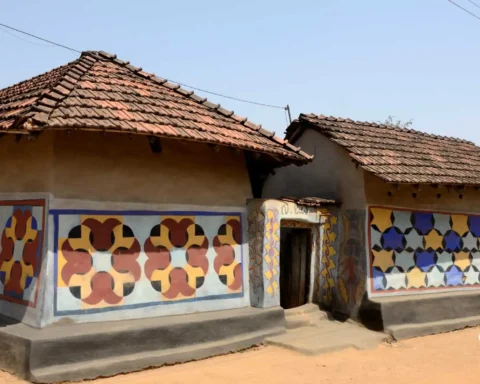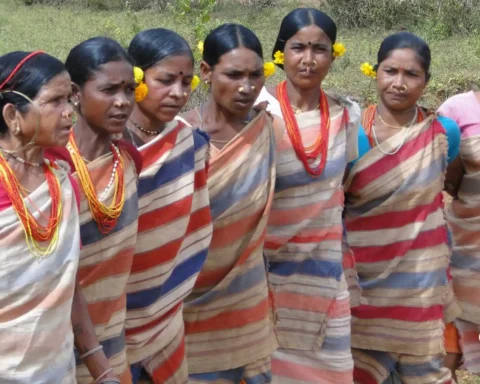Chutney music, a vibrant and rhythmic genre originating from the Caribbean, is often overshadowed by its more popular counterparts like reggae and calypso. However, delving into the history of chutney music reveals its diversity of cultural influences, migration patterns, and artistic innovation. In this comprehensive exploration, we will delve deep into the inspiring journey of chutney music, tracing its evolution from its humble beginnings to its global reach today.
Table of Contents
Indian Folk Music
Indian folk music forms the cultural backbone of communities across the globe, serving as a vessel for storytelling, cultural expression, and social cohesion. Rooted in centuries-old traditions, Indian folk music encompasses a diverse range of styles, reflecting the varied landscapes, languages, and customs of the subcontinent. From the soul-stirring melodies of Baul music in Bengal to the spirited rhythms of Dandiya Raas in Gujarat, each region boasts its unique folk traditions, passed down through generations.
The Birth of Chutney Music
The history of chutney music traces back to the 19th century when East Indians migrated to the West Indian islands, particularly Trinidad and Tobago, bringing with them their rich cultural heritage, including folk music traditions. These immigrants faced numerous challenges as they adapted to their new surroundings, but they found solace and connection through music, using it to preserve their cultural identity.
The Inspiring History of Chutney Music
Chutney music has its roots in Trinidad and Tobago, where it emerged as a fusion of Indian rhythms, melodies, and folk traditions with elements of Caribbean soca and calypso. The term "chutney" itself is derived from the Hindi word "chatni," referring to a spicy condiment commonly used in Indian cuisine. Early chutney music often featured lyrics sung in Hindi, Bhojpuri, or other Indian languages, reflecting the cultural heritage of the Indo-Trinidadian community.
The origins of chutney music can be traced back to the arrival of indentured labourers from the Indian subcontinent, particularly from states like Bihar, Uttar Pradesh, Bengal, and the South Indian areas to the Caribbean in the 19th century. These migrants brought with them their musical traditions, including bhajans, folk songs, and classical ragas, which they adapted to reflect their new surroundings. Over time, these musical styles intermingled with Afro-Caribbean rhythms, resulting in the birth of chutney music.
One of the earliest recorded chutney songs is believed to be "Jhum Jhum Jhumroo" by Ramdew Chaitoe, released in the 1950s. This song laid the foundation for the genre, blending Indian melodies with calypso rhythms and lyrics in Sarnami, a dialect of Bhojpuri spoken by Indo-Caribbean communities.
YOU MIGHT BE INTERESTED IN: Indianness in Trinidad & Tobago: Identity, Religion and Culture Explored with Dr. Sherry-Ann Singh
Instruments Used
In chutney music, a variety of instruments are used to create its distinctive sound, blending elements of Indian classical music with Caribbean rhythms. Some of the key instruments commonly found in chutney music include:
Dholak: The dholak is a two-headed drum widely used in Indian music. Its rhythmic beats provide the backbone of chutney music, driving the tempo and adding energy to the compositions.
Harmonium: The harmonium is a keyboard instrument that produces sound by air blown through reeds. It is often used in chutney music to provide melodic accompaniment and harmony to the vocals.
Tabla: The tabla is a pair of hand drums consisting of a small drum (dayan) and a larger drum (bayan). It is commonly used in Indian classical music and adds intricate rhythms and percussive textures to chutney music.
Tassa: The tassa is a type of drum originating from North India. It is played with sticks and is known for its high-pitched and piercing sound. In chutney music, the tassa is often used to accentuate rhythms and create dynamic flourishes.
Keyboard/Synthesizer: Modern chutney music often incorporates electronic keyboards or synthesizers to create additional layers of sound and add modern production elements to the music.
Guitar: While not traditionally associated with Indian music, the guitar has found its way into chutney music, particularly in contemporary chutney soca compositions. It adds a Western flavour to the music and complements the traditional Indian instruments.
Brass Instruments: Brass instruments such as the trumpet and saxophone are occasionally used in chutney music arrangements, especially in larger ensembles or bands. They contribute to the overall richness and depth of the musical arrangements.
Percussion: Various percussion instruments such as the dhol, dhantal, and dholakpur are also used in chutney music to provide additional rhythm and texture to the compositions, adding to the festive and celebratory atmosphere of the music.
These instruments, both traditional and modern, come together to create the vibrant and eclectic sound of chutney music, reflecting the cultural fusion and diversity of the Indo-Caribbean community.
The Global Groove: How the History of Chutney Music Went Worldwide
While chutney music initially gained popularity within Trinidad and Tobago's Indo-Caribbean community, its infectious rhythms soon caught the attention of music enthusiasts worldwide. In the 1980s and 1990s, chutney music experienced a surge in international recognition, thanks in part to the efforts of pioneering artists like Sundar Popo and Drupatee Ramgoonai. Their innovative blend of Indian melodies with Caribbean soca beats captivated audiences far beyond the shores of Trinidad and Tobago, leading to the global spread of chutney music.
Sundar Popo, often hailed as the "King of Chutney," played a pivotal role in popularizing chutney music both locally and internationally with hits like "Nana and Nani" and "Scorpion Gyul." His soulful voice and infectious melodies resonated with listeners across the Caribbean diaspora, earning him a devoted fan base.
Drupatee Ramgoonai, known for her groundbreaking fusion of chutney with soca rhythms, introduced a new dynamic to the genre, earning widespread acclaim and paving the way for future generations of chutney artists. Her smash hit "Roll Up De Tassa" became an anthem of sorts, blending traditional Indian drumming with soca beats to create a uniquely Trinidadian sound.
Celebrating Indo-Caribbean Culture
Chutney music, born out of the Indo-Caribbean community's vibrant cultural tapestry, combines elements of Indian folk music with Caribbean rhythms, creating a dynamic and infectious sound that resonates with audiences worldwide. Originating in Trinidad and Tobago, chutney songs celebrate themes of love, life, and community, often featuring upbeat melodies, catchy rhythms, and colourful lyrics. From classics by iconic artists like Sundar Popo to contemporary hits by modern chutney artists like Nisha Benjamin, chutney music continues to captivate audiences with its infectious energy and cultural resonance.
The Global Impact of Chutney Music
From the bustling streets of Trinidad to the diaspora communities of South Africa and beyond, chutney music has transcended geographical boundaries to become a global phenomenon. Whether performed at weddings, festivals, or community gatherings, chutney music continues to unite people of all backgrounds, celebrating the rich tapestry of Indo-Caribbean culture and heritage.
Artists That Shaped the History of Chutney Music
Throughout its evolution, chutney music has been shaped by a diverse array of talented artists who have left an indelible mark on the genre. Alongside Sundar Popo and Drupatee Ramgoonai, artists like Rikki Jai, Adesh Samaroo, and Terry Gajraj have contributed to chutney music's rich tapestry.
In the modern era, chutney music gained prominence thanks to artists like Rikki Jai and Terry Gajraj. These trailblazing musicians played a pivotal role in popularizing chutney music, infusing it with contemporary influences and expanding its appeal to a wider audience. Their innovative compositions and electrifying performances brought chutney music to the forefront of the Indian music scene, captivating listeners with their infectious rhythms and soulful melodies.
Rikki Jai, known for his energetic stage presence and infectious tunes, rose to prominence in the 1990s with hits like "Sumintra" and "Barman." His ability to blend chutney with soca, dancehall, and hip-hop elements helped broaden the genre's appeal and attract new audiences.
Adesh Samaroo, often called the "Chutney Emperor," is renowned for his melodious voice and romantic ballads. His songs, such as "Dulahin" and "Raat Ke Sapna," have become staples at weddings and parties, earning him a loyal following both in Trinidad and Tobago and abroad.
Terry Gajraj, a Guyanese-born artist, has been instrumental in popularizing chutney music in North America and Europe. His fusion of traditional chutney with contemporary influences has garnered him international acclaim, making him a trailblazer in the global chutney music scene.
In recent years, modern chutney artists like Moean Mohammed and Terry Gajraj have emerged as leading voices in the genre, infusing traditional chutney music with contemporary influences and innovative sounds. With their electrifying performances and boundary-pushing compositions, these artists are pushing the boundaries of chutney music, attracting a new generation of fans while staying true to the genre's rich heritage.
Anisa Singh is an environmental advocate and a highly celebrated musician, recording artist, and songwriter in the Caribbean. With over 22 years of experience, she is renowned for her captivating live Chutney music performances, captivating audiences with her melodious voice and vibrant stage presence. Anisa's versatile talents transcend boundaries, enriching cultural heritage and inspiring music enthusiasts worldwide.
YOU MIGHT BE INTERESTED IN: Redefining Cultural Boundaries through Chutney Music with Anisa Singh
Chutney Soca and the Modern Era
In recent years, chutney music has evolved further with the emergence of chutney soca, a high-energy fusion genre that combines elements of chutney with soca music. Artists like Nisha Benjamin have been at the forefront of this evolution, pushing the boundaries of traditional chutney music and attracting a wider audience with their infectious beats and catchy lyrics. Chutney soca has become a staple of Trinidad and Tobago's carnival celebrations, further cementing its status as a dynamic and vibrant genre.
Is Chutney Music Dying?
Despite its rich history and cultural significance, chutney music faces challenges in the modern music landscape. As younger generations gravitate towards mainstream genres like hip-hop and pop, traditional forms of chutney music risk being overshadowed and forgotten. Additionally, the commercialization of music production has led to a homogenization of sound, diluting the distinctiveness of chutney music's traditional elements.
However, dedicated artists and enthusiasts continue championing the genre, ensuring its legacy endures. Chutney music festivals, such as the annual Chutney Soca Monarch competition in Trinidad and Tobago, provide a platform for artists to showcase their talent in the flourishing Indian community and keep the genre alive. Moreover, initiatives to preserve chutney music's cultural heritage, such as archival projects and educational programs, play a crucial role in ensuring its longevity.
Preserving the Legacy: Indo-Caribbean Music in the 21st Century
As chutney music continues to evolve and adapt to changing musical landscapes, it remains an integral part of the Indo-Caribbean community's cultural identity. Organizations and initiatives dedicated to preserving Indo-Caribbean music, such as the Indo-Caribbean Cultural Council, play a vital role in safeguarding this rich heritage for future generations. By celebrating the contributions of chutney singers like Rikki Jai, Terry Gajraj, and Nisha Benjamin, we ensure that the legacy of chutney music lives on, inspiring and captivating audiences for years to come.
Despite the ever-evolving music scene, chutney artists remain committed to preserving and promoting traditional Indo-Caribbean culture through their music. From reviving classic folk songs to composing original chutney compositions, artists like Ramdeo Chaitoe and Ramdew Chaitoe are ensuring that the rich legacy of chutney music lives on for future generations to enjoy.
Why Does the History of Chutney Music Matter Today?
Understanding the history of chutney music is essential for preserving and celebrating the cultural heritage of the Indo-Caribbean community. It serves as a testament to the resilience and creativity of migrants who brought their traditions and music with them to distant shores. Moreover, chutney music's fusion of Indian and Caribbean influences exemplifies the power of cultural exchange and collaboration in shaping artistic expression.
By exploring the history of chutney music, we gain insight into the diverse tapestry of human experience and how music serves as a bridge between cultures. It reminds us of the importance of preserving and honouring our collective heritage, ensuring that future generations can enjoy and appreciate chutney music's rich cultural mosaic.
Beyond Entertainment: Chutney Music as Cultural Commentary
Chutney music also serves as a platform for social commentary, addressing issues such as economic hardship, cultural identity, and social justice within the Indo-Caribbean community. Through their lyrics and melodies, artists like Vedesh Sookoo and Chris Garcia shed light on the challenges and triumphs of Caribbean life, sparking important conversations and fostering a sense of solidarity among listeners.
YOU MIGHT BE INTERESTED IN: Music, Culture, and Indianness: The Journey of Ila Arun
Conclusion
As chutney music evolves and adapts to the changing times, its essence remains rooted in the traditions, values, and experiences of the Indo-Caribbean community. The history of chutney music is a testament to the resilience and creativity of the Indo-Caribbean community. From its humble beginnings in the sugar estates of Trinidad to its global reach today, chutney music serves as a powerful symbol of resilience, creativity, and cultural pride, enriching the lives of millions around the world. Through its infectious rhythms and heartfelt lyrics, this popular music continues to inspire, entertain, and unite people across generations, ensuring its legacy will endure for years.
FAQs
Who is the father of chutney music?
Sundar Popo is credited as the father of chutney music.
Why is Chutney music popular?
Chutney music's catchy mix of Indian melodies with calypso and soca rhythms creates a high-energy sound perfect for parties and celebrations. It also celebrates Indo-Caribbean heritage and culture.
What is the origin of Bhojpuri music?
Bhojpuri music's roots likely lie in 7th-century folk traditions and devotional songs sung in the Bhojpuri language.











[…] lyrics of music of Indian origin have their roots in classical music and play a significant role in shaping the […]
[…] burlesque combines the best aspects of both genres, offering a night of music, comedy, and dance in an intimate, cabaret-style evening. These performances often occur in […]